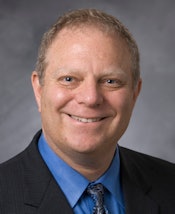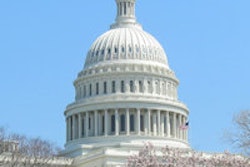
The International Society for Computed Tomography (ISCT) is returning to where it left its heart -- in San Francisco. The City by the Bay will once again host radiology's most prominent meeting dedicated to CT, from June 9-14, with a few twists in store for both attendees and those watching the proceedings online.
After a stint last year in Washington, DC, ISCT returns with its signature mix of CT technologies and radiology thought leaders in a new format that combines presentations and workshops with content on demand via the Internet. As was the case the past two years, all conference proceedings will be streamed live on AuntMinnie.com, making meeting content available around the world.
Broader access
This year will see a few structural changes designed to take advantage of the live and on-demand streaming options available, according to program director Dr. Geoffrey Rubin, professor of radiology and bioengineering at Duke University.
 Dr. Geoffrey Rubin from Duke University.
Dr. Geoffrey Rubin from Duke University.
The most visible change in the program is a series of workshops -- one on dual-energy/spectral CT and another on percutaneous aortic valve implantation -- that will take place concurrently with the more traditional rapid-fire 10-minute lectures and even a handful of 20-minute talks, Rubin told AuntMinnie.com.
Holding workshops during the meeting means that attendees won't be able to see everything on offer just by camping out in the Grand Ballroom of the Hyatt Regency, and they don't have to be there. Any lecture an attendee might miss -- whether to attend one of the workshops or to take the slow way back from lunch -- can be accessed online permanently.
"Because we're now streaming the lectures, I think people are feeling less compelled to be in the room, freeing them up to do the simultaneous workshops, knowing that they can look back and hear the lectures later on," he said.
From bleeding edge to clinical routine
The workshops' focus on case-based learning and incorporating new technologies into practice also reflects a new confidence with several clinical procedures that until recently were considered experimental, Rubin said.
Procedures such as stress perfusion cardiac and brain perfusion CT, as well as spectral CT, are making their way into routine practice. As a result, several presentations will focus on "the experimental stuff becoming more of a real-world experience," he said.
Take dual-energy or spectral CT, where "we're basically devoting an entire workshop to focus on the nuts and bolts of bringing it into people's practices," Rubin said. Also, "iterative reconstruction has become more of a mainstream than an experimental tool," and the meeting content will reflect its growing use in day-to-day radiology.
There is new technology this year as well, beginning with two new CT platforms: GE Healthcare's entry into wide-area CT, joining Toshiba Medical Systems in that market space, as well as Siemens Healthcare's debut of its third-generation dual-source scanner. Their applications and implications will be covered in this year's ISCT sessions, according to Rubin.
The meeting opens with a joint presentation on the history of multidetector scanning from 1989 to the present by Rubin and MDCT pioneer Willi Kalender, PhD, from the University of Erlangen in Germany.
Radiation dose evolves, too
Radiation dose reduction certainly isn't new, but much surrounding it is. Important new methods have emerged to make it more reliable, and discussion of these tools has been incorporated into the ISCT meeting program, according to Rubin.
This year, for example, "there's a lot more experience within the concept of mandatory reporting, how to implement dose reduction within a multisite health system, and how to effectively do this reporting and make it value added," he said. "So that's a big change from the high-level mandate of reducing radiation exposure and why we should do it."
That said, the technology, science, and practice of dose reduction remains a work in progress.
"Even though we've made some important steps, we're still at a fairly intermediate stage, in that ideally what we [should] report is as relevant as possible to actual patient risk, so that we neither over- nor underestimate it," Rubin said. As a result, meeting attendees will hear talks that touch on "all of its complexities," he added.
Lung cancer screening in practice
This year, lung cancer screening with CT also looms large, as the U.S. gears up to offer screening to long-term smokers population-wide, potentially including Medicare patients.
"Lung cancer screening is huge," he said. Accordingly, ISCT sessions will incorporate not just the science, but also the economics and practice management aspects of lung cancer screening, "particularly around optimizing utilization and improving quality and reliability in CT."
Free streaming broadens audience
As in the past two years, all of the conference proceedings will be streamed live on AuntMinnie.com, beginning at 7 a.m. Pacific time on June 9 at isct.auntminnie.com. Live streaming on AuntMinnie.com is an important component of the meeting that advances some of ISCT's core goals, according to Rubin.
"Streaming is a great enabler of the mission of ISCT in that it offers the material as broadly as possible worldwide -- and our metrics from streaming confirm that we have participants and viewers from all of the regularly inhabited continents of the world, excluding Antarctica," he said. "It really is a way for us to make the information and content available to those who otherwise wouldn't be able to attend."
The idea is to offer a flexible conference model that gives people as many ways to participate as possible. In the past, "there was only one option: Come to San Francisco and be in the room," Rubin said. Now there are more options, beginning with free access worldwide, and because of it "there may be fewer people in the room than during our peak, but many more participating."
Onsite attendees will have permanent access to archived presentation material, along with opportunities to attend the two workshops and interact with the presenters and meeting directors in San Francisco. Online attendees will have paid options for revisiting the content and receiving CME credit.
This year's meeting director and eight co-directors hail from Stanford University, Duke University, and other centers of excellence around the world, according to Rubin.
"The goal is to evolve the organization into one that has more broad input and provides opportunity for more people to participate," he said "We're still working on what ISCT will look like moving forward, so I've engaged some of our most longstanding faculty members" to help shape the meeting and its future, with the help of a new board of directors that recently had its first meeting.
Meanwhile, the European arm of ISCT will continue hosting its meeting in Europe every two years; the next one is in January 2016. But Rubin said there are no plans to continue rotating the U.S. meeting to other cities, as occurred in Las Vegas in 2008 and Washington, DC, in 2013.
"I heard a lot of feedback from folks in Washington that they really prefer to be in San Francisco," he said. "Our inclination right now and our plan is to stay in SF."
More information is available on the ISCT website.




















